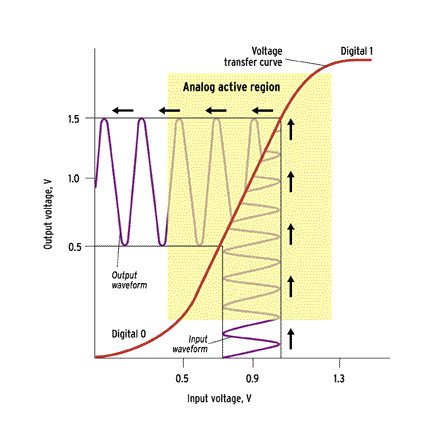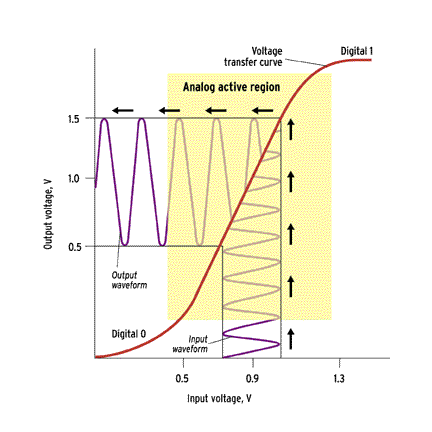This is the digital age. From flashy cell phones, games, PCs, and PDAs to the behind-the-scenes automotive, medical, and Internet components, progress in digital computing owes much to the software that helps designers create and connect millions of transistors. But with the trend toward mixed-signal chips in a communications-centric world, everyone is finding the need for a little bit of analog. As many electronic products get smaller yet do more, designers face special challenges as they add analog circuitry to an otherwise digital chip.
Only recently have analog/mixed-signal designers had any help from electronic design automation (EDA) software. Now the established EDA vendors and a group of start-ups are competing for a share of the growing analog/mixed-signal chip design business. The result is a steady stream of new tools.
Hottest on the list of new EDA offerings are the so-called analog synthesis programs, which offer an automated way to turn specifications into a working component. Unfortunately, they are not as well known as their digital counterparts.
Synthesis, which ushered in the modern age of digital design, lets designers describe circuit functions in terms of software code, rather than with symbols and schematics. This code is then compiled into a list of standard cells, the physical implementation of a logic function. Then, thanks to automated layout, a stable of engineers is no longer needed to place and connect the cells by hand; the computer does the job. With synthesis and automated placement and routing, chip designers can cut design cycle time drastically–digital chip designers, that is.
For analog designers, it’s a different story. While digital designers are automating the time-consuming grunt work and focusing on creating more and better electronics, analog designers have been doing things the old-fashioned way–manually. But that situation may be changing.
In fact, growing interest in analog/mixed-signal design was very much apparent at the International Solid-State Circuits Conference in San Francisco last February. Even digital designers packed into sessions on analog and radio frequency circuits, hoping to glean some insights into the integration of high-performance analog and digital components on the same chip.
The Semiconductor Industry Association, San Jose, Calif., predicts that nearly 70 percent of all ICs will have analog components within five years, compared with about 25 percent today. For example, the much-anticipated short-link wireless technologies, like Bluetooth and IEEE 802.11, need an analog interface at the sending and receiving end of every device.
Considering that only 20002500 analog designers are working in North America, according to Gary Smith, an EDA analyst with Dataquest Inc., digital designers might be called upon to learn analog and mixed-signal design skills–attractive commodities in the communications, multimedia, and data storage markets.
Black magic to the rescue

Threading the Needle: Analog design tools must factor in the effect on a device’s output voltage of small changes in its input voltage, as shown by the IV curve of an operational amplifier. The steeper the curve, the greater the sensitivity.
Click on the image to enlarge view.
The differences between analog and digital circuits are vast. Digital circuits work by flipping transistors on and off to the states called 1 and 0. They can be described in high-level, hardware description languages (HDLs) and then synthesized into standard cells, which can contain multiplexers/demultiplexers, flip-flops, buffers, and logic gates. Digital circuits have a greater immunity to noise than analog ones because a range of signal values are associated with logical 1 and 0 [see figure]. This noise margin helps to lower performance sensitivity to standard cell placement and routing, making automation of those steps possible.
In contrast, analog circuits work by biasing the transistor somewhere between what the digital world would call fully on and fully off. These circuits don’t come in standardized packages; they must be sized and tweaked to work properly. Unlike digital circuits, they cannot yet be described in HDL. Instead analog circuits are characterized more along the lines of “give me an amplifier with a gain of 1000, and make it not burn out.” Design automation tools are not yet smart enough to turn that kind of description into a circuit layout. Analog designers manually draw the schematics and connect them so that the transistors stay in the delicate active region. It’s no wonder that building great analog circuits is said to involve some amount of black magic.
Because analog designs require skilled craftsmen, who are in short supply, and few parts of the typical analog flow are automated, the average analog circuit takes longer to implement than its usually much larger digital counterpart. Problems multiply if the analog design is destined to be a block on a mixed-signal or system chip. But progress is being made, enough to spark a revolution in EDA for analog/ mixed-signal (AMS) designers, who are now dealing with transistors in the range of millions.


